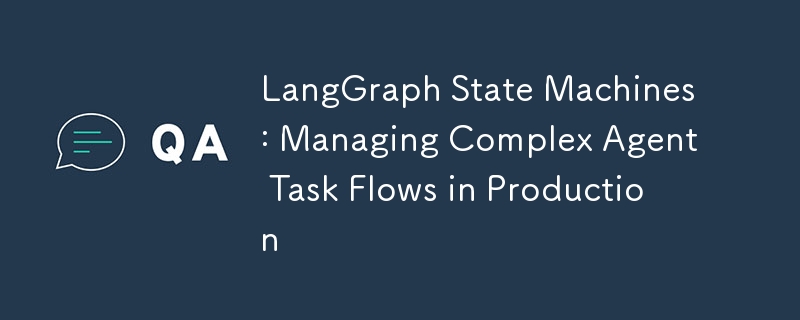

LangGraph est un framework d'orchestration de flux de travail conçu spécifiquement pour les applications LLM. Ses principes fondamentaux sont :
Pensez au shopping : Parcourir → Ajouter au panier → Commander → Paiement. LangGraph nous aide à gérer efficacement ces flux de travail.
Les états sont comme des points de contrôle dans l'exécution de vos tâches :
from typing import TypedDict, List
class ShoppingState(TypedDict):
# Current state
current_step: str
# Cart items
cart_items: List[str]
# Total amount
total_amount: float
# User input
user_input: str
class ShoppingGraph(StateGraph):
def __init__(self):
super().__init__()
# Define states
self.add_node("browse", self.browse_products)
self.add_node("add_to_cart", self.add_to_cart)
self.add_node("checkout", self.checkout)
self.add_node("payment", self.payment)
Les transitions d'état définissent la « feuille de route » de votre flux de tâches :
class ShoppingController:
def define_transitions(self):
# Add transition rules
self.graph.add_edge("browse", "add_to_cart")
self.graph.add_edge("add_to_cart", "browse")
self.graph.add_edge("add_to_cart", "checkout")
self.graph.add_edge("checkout", "payment")
def should_move_to_cart(self, state: ShoppingState) -> bool:
"""Determine if we should transition to cart state"""
return "add to cart" in state["user_input"].lower()
Pour garantir la fiabilité du système, nous devons conserver les informations d'état :
class StateManager:
def __init__(self):
self.redis_client = redis.Redis()
def save_state(self, session_id: str, state: dict):
"""Save state to Redis"""
self.redis_client.set(
f"shopping_state:{session_id}",
json.dumps(state),
ex=3600 # 1 hour expiration
)
def load_state(self, session_id: str) -> dict:
"""Load state from Redis"""
state_data = self.redis_client.get(f"shopping_state:{session_id}")
return json.loads(state_data) if state_data else None
Toute étape peut échouer, et nous devons gérer ces situations avec élégance :
class ErrorHandler:
def __init__(self):
self.max_retries = 3
async def with_retry(self, func, state: dict):
"""Function execution with retry mechanism"""
retries = 0
while retries < self.max_retries:
try:
return await func(state)
except Exception as e:
retries += 1
if retries == self.max_retries:
return self.handle_final_error(e, state)
await self.handle_retry(e, state, retries)
def handle_final_error(self, error, state: dict):
"""Handle final error"""
# Save error state
state["error"] = str(error)
# Rollback to last stable state
return self.rollback_to_last_stable_state(state)
Regardons un exemple pratique : un système de service client intelligent :
from langgraph.graph import StateGraph, State
class CustomerServiceState(TypedDict):
conversation_history: List[str]
current_intent: str
user_info: dict
resolved: bool
class CustomerServiceGraph(StateGraph):
def __init__(self):
super().__init__()
# Initialize states
self.add_node("greeting", self.greet_customer)
self.add_node("understand_intent", self.analyze_intent)
self.add_node("handle_query", self.process_query)
self.add_node("confirm_resolution", self.check_resolution)
async def greet_customer(self, state: State):
"""Greet customer"""
response = await self.llm.generate(
prompt=f"""
Conversation history: {state['conversation_history']}
Task: Generate appropriate greeting
Requirements:
1. Maintain professional friendliness
2. Acknowledge returning customers
3. Ask how to help
"""
)
state['conversation_history'].append(f"Assistant: {response}")
return state
async def analyze_intent(self, state: State):
"""Understand user intent"""
response = await self.llm.generate(
prompt=f"""
Conversation history: {state['conversation_history']}
Task: Analyze user intent
Output format:
{{
"intent": "refund/inquiry/complaint/other",
"confidence": 0.95,
"details": "specific description"
}}
"""
)
state['current_intent'] = json.loads(response)
return state
# Initialize system
graph = CustomerServiceGraph()
state_manager = StateManager()
error_handler = ErrorHandler()
async def handle_customer_query(user_id: str, message: str):
# Load or create state
state = state_manager.load_state(user_id) or {
"conversation_history": [],
"current_intent": None,
"user_info": {},
"resolved": False
}
# Add user message
state["conversation_history"].append(f"User: {message}")
# Execute state machine flow
try:
result = await graph.run(state)
# Save state
state_manager.save_state(user_id, result)
return result["conversation_history"][-1]
except Exception as e:
return await error_handler.with_retry(
graph.run,
state
)
Principes de conception de l'État
Optimisation de la logique de transition
Stratégie de gestion des erreurs
Optimisation des performances
Explosion d'État
Situations d'impasse
Cohérence de l'État
Les machines à états LangGraph fournissent une solution puissante pour gérer les flux de tâches complexes des agents IA :
Ce qui précède est le contenu détaillé de. pour plus d'informations, suivez d'autres articles connexes sur le site Web de PHP en chinois!
 niveau d'isolement des transactions par défaut de MySQL
niveau d'isolement des transactions par défaut de MySQL
 Qu'est-ce que la monnaie numérique
Qu'est-ce que la monnaie numérique
 La différence entre les fonctions fléchées et les fonctions ordinaires
La différence entre les fonctions fléchées et les fonctions ordinaires
 Nettoyer les fichiers indésirables dans Win10
Nettoyer les fichiers indésirables dans Win10
 point de symbole spécial
point de symbole spécial
 À quelles touches les flèches font-elles référence dans les ordinateurs ?
À quelles touches les flèches font-elles référence dans les ordinateurs ?
 Comment utiliser la fonction Print() en Python
Comment utiliser la fonction Print() en Python
 Il y a une page vierge supplémentaire dans Word et je ne parviens pas à la supprimer.
Il y a une page vierge supplémentaire dans Word et je ne parviens pas à la supprimer.